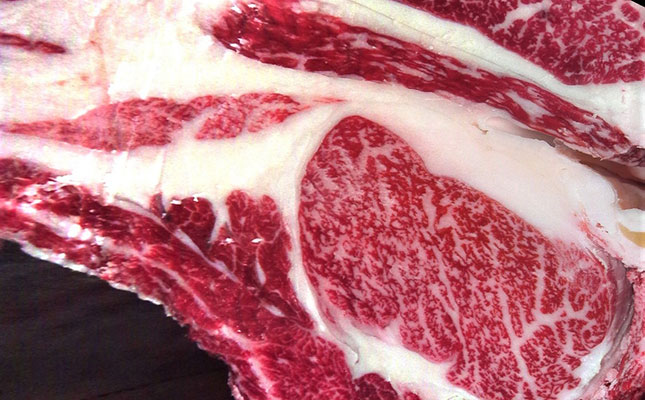
Photo: Wagyu South Africa
Members of South Africa’s five-year-old Wagyu South Africa beef cattle society have expressed excitement about the rare 15 marbling score recently achieved by a locally produced 490,4kg and DNA-verified Wagyu x Angus carcass.
According to the society’s CEO, Dr Michael Bradfield, after being slaughtered in South Africa, the carcass was scanned at the abattoir with an R800 000 high-tech Meat Image Japan carcass analysis camera, and the images sent to Japan for impartial electronic evaluation.
READ Are top-priced genetics really worth it?
Wagyu cattle, which originate in Japan, produce the most expensive beef in the world. The beef is renowned for its flavour, texture and overall eating experience largely resulting from Wagyu genetics’ higher than average intramuscular fat, also referred to as marbling.
Bradfield told Farmer’s Weekly that most western countries used marbling as a proxy of meat quality for juiciness, flavour, tenderness and taste, providing the ultimate consumer experience.
“The Australian system scores marbling from one to nine, with a nine considered exceptional. The Japanese system scores marbling from one to 12. Anything between eight and 12 is considered excellent,” he explained.
READ Belgian racing pigeon sells for record price of R29 million
Bradfield added that an important aspect when scoring marbling in beef was to evaluate the distribution and evenness of the fine intramuscular fat. It was undesirable to have large clumps of fat within the muscle.
According to information provided by Wagyu South Africa, this particular carcass was recently auctioned online via the WagyuX website. Bred by Brian Angus of Woodview Wagyu in the Free State, and finished and owned by Morgan Beef in Mpumalanga, it was sold to an as yet unidentified buyer for R82,50/kg or a total price of R40 458.
Bradfield said that although the purchase price was somewhat disappointing, “it’s early days in our industry” and the meat from the carcass “will retail for far more”.
READ Fake meat: coming to a supermarket near you
In addition to the chart-breaking score achieved by this carcass, another highlight for South Africa’s young Wagyu beef sector took place at the 2019 Royal Show in KwaZulu-Natal.
Farmer’s Weekly reported at the time that the 430kg Wagyu-cross carcass that went under the hammer at the show’s prestigious annual carcass auction, had a marbling score of six out of nine on the Australian scale.
It was sold to Gauteng-headquartered butchery, Zingela Meat Co, for R372,09/kg or a total price of R159 998,70.
“We’ve started exporting some of our Wagyu; mostly to the Middle East and Asia. We’re also working hard with some of South Africa’s leading brands to put more Wagyu on menus and in meat fridges. Wagyu services a high-premium sector, but the portions are generally sold smaller than other beef because Wagyu is so rich, and is affordable to the general public when sold as forequarter cuts. Wagyu beef is a delicacy; it’s niche, and luxurious,” Bradfield said.










